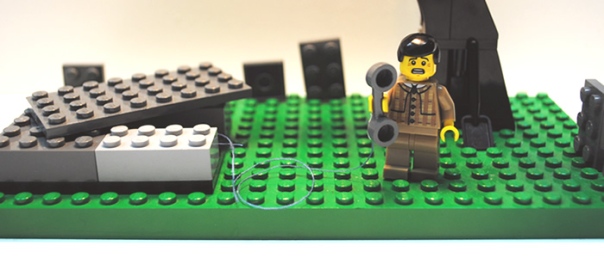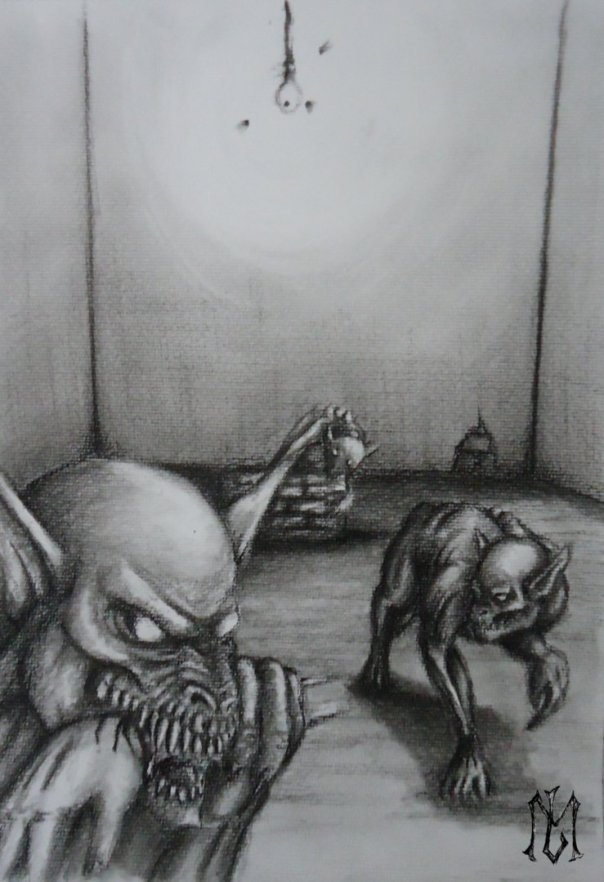 Warren meets his Doom by Frohickey (www.deviantart.com)
Warren meets his Doom by Frohickey (www.deviantart.com)
When Harley Warren entered the under-ground crypt in that forgot graveyard in the Big Cypress Swamp, he discovered something that cost him his life. He had an idea something aberrant was lurking in that tomb, which is why he would not let his friend Randolph Carter go down with him. However, what Warren thought was down there and what was revealed to be there were probably two very different things. To analyze exactly what was down in that under-ground tomb, I want to discuss H.P. Lovecraft’s “The Statement of Randolph Carter” from both a macro-scale and a micro-scale.
From a macro-scale perspective, Warren may have stumbled into a portal in that tomb that connects our Space-Time to another Universe. There are a unique sub-group of Lovecraft’s tales that hint at the possibility that our Universe is some connected or super-positioned onto another one. Stories such as “The White Ship,” “Pickman’s Model,” “The Nameless City,” “The Festival,” and “Celephais” all provide evidence for the existence of another Universe and the possibility for entities from one Universe visiting the other. The portal or bridge between the two Universe could be a specific location in our Space-Time, the use of some type of alien technology or methodology, or simply dreams. The under-ground tomb in that Floridian swamp may have been one of these portals and Warren may have found this out through the book he was carrying, written in alien characters. It has been questioned whether or not this book is perhaps at least a partial translation of the Necronomicon (Joshi, 1999; Klinger, 2014). Similar to Walter Gilman in “Dreams in the Witch-House,” Warren may have found a formula or methodology that could be used to access higher dimensions to open a portal to another Universe. If indeed Warren opened a portal and peered into it, it would help explain some of this statements to Carter such as “God! If you could seed what I am seeing!”, “Carter, it’s terrible – monstrous – unbelievable!”, and “It’s too utterly beyond thought – I dare not tell you – no man could know it and live – Great God! I never dreamed of this.” Are these statements Warrens attempt to understand what he was seeing – a portal that opened up from one Universe (or brane) to another and what was on the other side?
 Harley Warren by Sara Bardi (www.dreamquestofunknownkadath.com)
Harley Warren by Sara Bardi (www.dreamquestofunknownkadath.com)
Modern cosmology is not considered the pseudoscience it was in the past and current hypotheses on the nature of reality may help to explain what Warren experienced. Super String theory (also known as String theory) is an attempt to describe a unified field theory (a theory for everything) that would unite all four forces of nature (gravity, electromagnetism, strong nuclear force and weak nuclear force), based on tiny, micro-atomic strings vibrating in 10 or 11-dimensional Space-Time. A strong point of String theory is that it integrates gravity, where other theories cannot. A weak point of String theory is that it cannot provide solutions for every aspect of its model. Thus, a number of solutions are being investigated for M-Theory (essentially an extension of String theory) that include super-symmetry as well as the possibility of adding another dimension into the calculations (www.mkaku.org). For the sake of this discussion, Warren may have opened a portal from our Space-Time brane to another brane (potentially the Dreamlands). Additionally, our brane and the Dreamlands brane may be a series of branes that are single parts of a complex Multiverse that extends into our Space-Time as well as into higher dimensions.
 Proposed ideas of M-theory and the Multiverse (illustration by Steve Duenes of the New York Times)
Proposed ideas of M-theory and the Multiverse (illustration by Steve Duenes of the New York Times)
From a micro-scale perspective, we have very little information on what the “things” or entities were that Warren encounters in the under-ground tomb. Two hypotheses are proposed. First, they may be the individuals that were somehow brought back to life through some unknown mechanisms but possibly similar to Dr. Herbert West’s serum in “Herbert West – Reanimator.” Possibly the unique environmental conditions under-ground and/or being adjacent to the portable to the Dreamlands brane, reanimates the dead. This would explain the statement “…why certain corpses never decay, but rest firm and fat in their tombs for a thousand years.” Of course a recently dead individual would probably understand how to use a telephone and speak English so the chilling response Carter gets at the end of the tale would be understandable.
 The Statement of Randolph Carter by Cheesecake Weasel (www.deviantart.com)
The Statement of Randolph Carter by Cheesecake Weasel (www.deviantart.com)
An alternative hypothesis is the entities are not reanimated dead but instead ghouls, creatures that may be an extreme variation of human genetic / evolution and/or the result of some type of genetic disease (possibly triggered by a virus or prion). Under a certain set of circumstances humans can visit the Dreamlands brane but ghouls seem to accomplish this with a higher degree of ease and frequency relative to humans. Indeed, ghouls may take advantage of this ability as a means of traveling largely unseen from graveyard to graveyard. Whether this ability is largely based on an intrinsic, genetic ability of the ghouls or of knowledge / technology on how to utilize dreams and access portals to move between the branes is largely unknown.
 Ghoul’s Graveyard by Mark Foster (www.hplovecraftart.blogspot.com)
Ghoul’s Graveyard by Mark Foster (www.hplovecraftart.blogspot.com)
If the ghoul hypothesis is correct, the idea of certain corpses that never decay and appear to be firm and fat may be ghouls posing as the dead to avoid being discovered. If this is the case, then Harley Warren did more just examine dead bodies in the tomb. Maybe Warren knew this under-ground tomb in Florida was one of the points where our Space-Time’s brane connected to another (the Dreamlands brane?) and he somehow accessed or opened this connection. This would have easily upset the ghouls, either posing as the dead or possibly coming from the other brane entering ours to find Warren. To keep their existence, as well as the ability to travel to other universes a secret, it is not surprising that the ghouls would kill Warren and tell Carter that “…Warren is Dead!” Using superstition to keep knowledge on the nature and structure of Space-Time, reality and the Multiverse a secret is a re-occurring theme in many of Lovecraft’s writings.

The climatic scene from Lovecraft’s “The Statement of Randolph Carter” as shown in Lego format (www.littleempire.blogspot.com)
Next time more evidence of the M-theory in Lovecraft’s writings will be presented in a discussion of his tale “The White Ship.” Thank you – Fred.






















